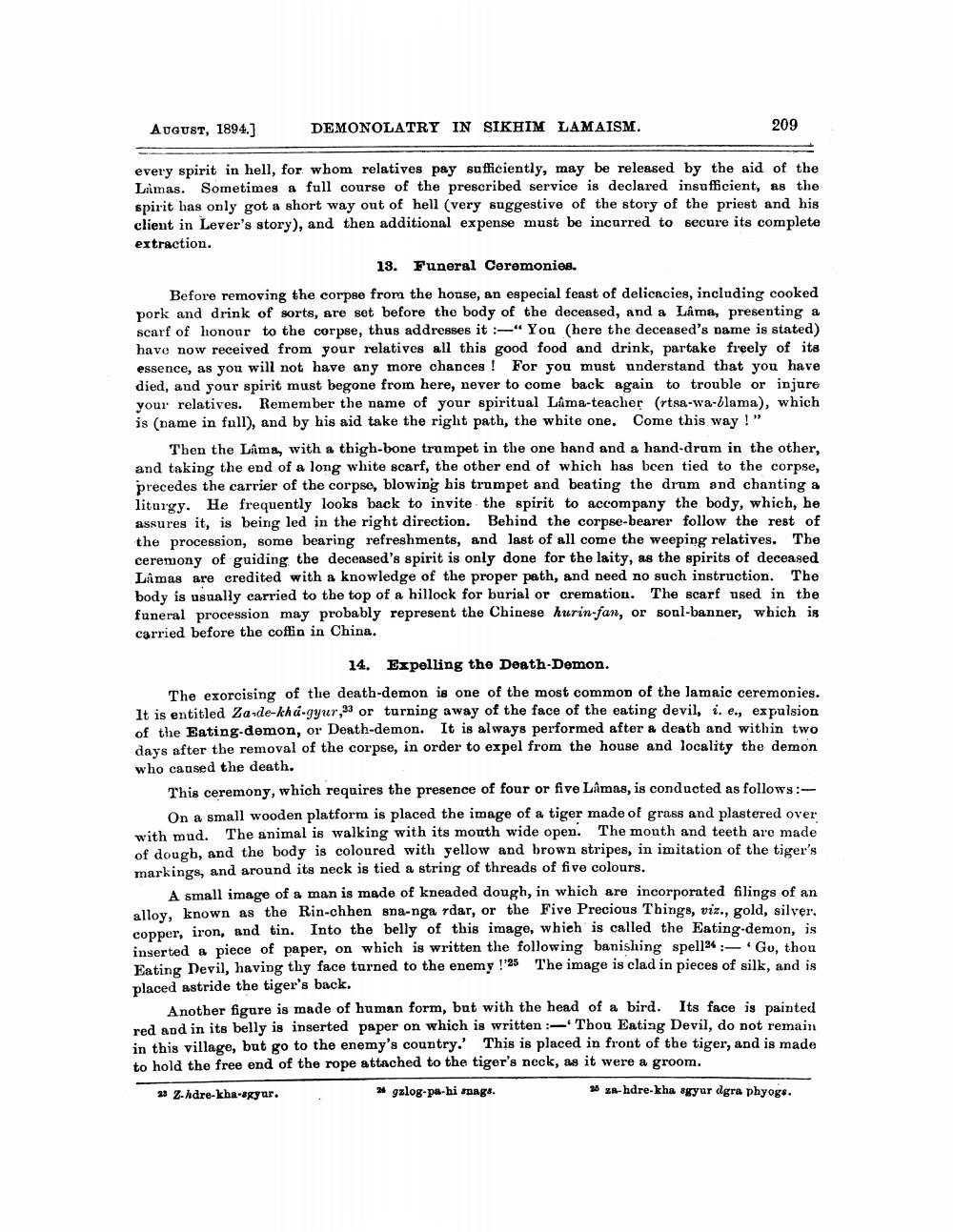________________
AUGUST, 1894.]
DEMONOLATRY IN SIKHIM LAMAISM.
209
every spirit in hell, for whom relatives pay sufficiently, may be released by the aid of the Limas. Sometimes a full course of the prescribed service is declared insufficient, as the spirit has only got a short way out of hell (very suggestive of the story of the priest and his client in Lever's story), and then additional expense must be incurred to secure its complete extraction.
13. Funeral Ceremonies. Before removing the corpse from the house, an especial feast of delicacies, including cooked pork and drink of sorts, are set before the body of the deceased, and a Lama, presenting a scarf of honour to the corpse, thus addresses it "You (here the deceased's name is stated) have now received from your relatives all this good food and drink, partake freely of its essence, as you will not have any more chances ! For you must understand that you have died, and your spirit must begone from here, never to come back again to trouble or injure your relatives. Remember the name of your spiritual Lima-teacher (rtsa-wa-blama), which is (name in fall), and by his aid take the right path, the white one. Come this way !”
Then the Lama, with a thigh-bone trumpet in the one hand and a hand-drum in the other, and taking the end of a long white scarf, the other end of which has been tied to the corpse, precedes the carrier of the corpse, blowing his trumpet and beating the drum and chanting a liturgy. He frequently looks back to invite the spirit to accompany the body, which, he assures it, is being led in the right direction. Behind the corpse-bearer follow the rest of the procession, some bearing refreshments, and last of all come the weeping relatives. The ceremony of guiding the deceased's spirit is only done for the laity, as the spirits of deceased Lamas are credited with a knowledge of the proper path, and need no such instruction. The body is usually carried to the top of a hillock for burial or cremation. The scarf used in the funeral procession may probably represent the Chinese hurin-fan, or soul-banner, which is carried before the coffin in China.
14. Expelling the Death-Demon. The exorcising of the death-demon is one of the most common of the lamaic ceremonies. It is entitled Za de-kha-gyur,33 or turning away of the face of the eating devil, i.e., expulsion of the Eating.demon, or Death-demon. It is always performed after a death and within two days after the removal of the corpse, in order to expel from the house and locality the demon who caused the death.
This ceremony, which requires the presence of four or five Lamas, is conducted as follows:
On a small wooden platform is placed the image of a tiger made of grass and plastered over with mud. The animal is walking with its mouth wide open. The mouth and teeth are made of dough, and the body is coloured with yellow and brown stripes, in imitation of the tiger's markings, and around its neck is tied a string of threads of five colours.
A small image of a man is made of kneaded dough, in which are incorporated filings of an alloy, known as the Rin-chhen sna-nga rdar, or the Five Precious Things, viz., gold, silver, copper, iron, and tin. Into the belly of this image, which is called the Eating.demon, is inserted a piece of paper, on which is written the following banishing spel134 : Go, thou Eating Devil, having thy face turned to the enemy :'25 The image is clad in pieces of silk, and is placed astride the tiger's back.
Another figure is made of human form, but with the head of a bird. Its face is painted red and in its belly is inserted paper on which is written :- Thou Eating Devil, do not remain in this village, but go to the enemy's country. This is placed in front of the tiger, and is made to hold the free end of the rope attached to the tiger's neck, as it were a groom. 23 Z-hdre-kha-sgyar.
galog-pa-hi snags.
38 za-hdre-kha syur dgra phyogs.




